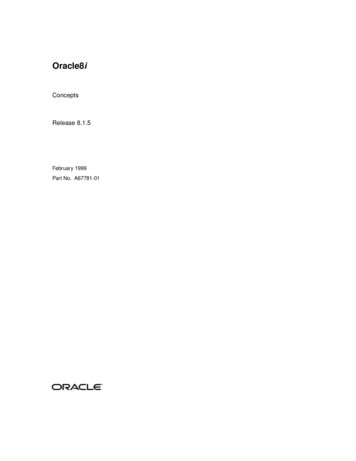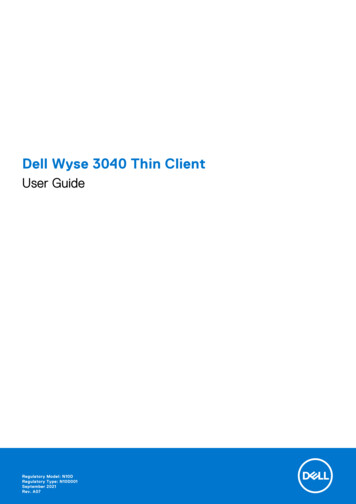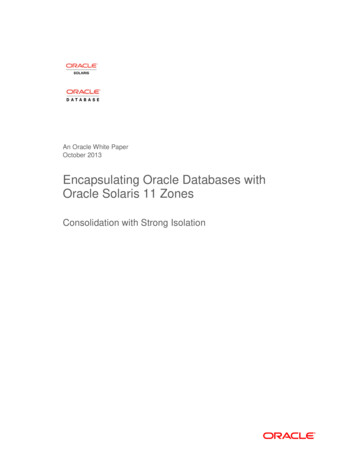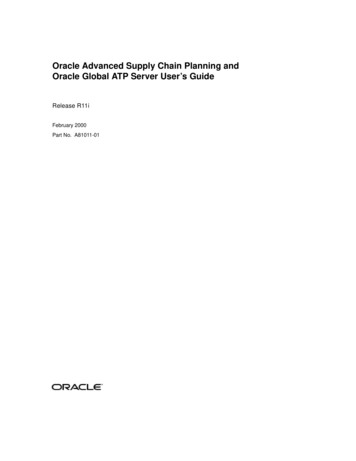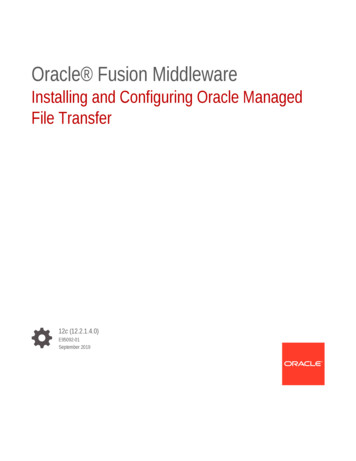
Transcription
A Joint Oracle Teradata White PaperSeptember 2011Configuring Oracle Business IntelligenceEnterprise Edition to Support TeradataDatabase Query Banding
Configuring Oracle BI EE Server to Support Teradata Database Query BandingIntroduction . 1Step 1. Query Band Configuration for OBIEE . 2Step 2. Testing Query Band Configuration . 5Conclusion . 6
Configuring Oracle BI EE Server to Support Teradata Database Query BandingIntroductionAll Oracle Business Intelligence users, by default, use the same database credentials whenthey login to the database. There are situations where it is beneficial to add user-specific orreport-specific information to the query request to enable different priority or simplify debuggingof query performance. One way to do so is to use the database feature called query banding.This paper will use the Teradata Database as the database handling the queries, but theprinciples are the same for any database that supports query banding functionality.1
Configuring Oracle BI EE Server to Support Teradata Database Query BandingStep 1. Query Band Configuration for OBIEEStart by adding a new execute before query item. Open the connection pool properties for theTeradata Database.Click on the “Connection Scripts” tab.Figure 12
Configuring Oracle BI EE Server to Support Teradata Database Query BandingExpand the “Execute before query” section.Figure 23
Configuring Oracle BI EE Server to Support Teradata Database Query BandingClick on the “New” button.Figure 3Now you need to decide what kind of information you want to add. You can add things that Oracle BIEE Server calls „request scope‟ variables. Read the Oracle BI documentation to determine which„request scope‟ variables are available for your versions.In this example we will add a user identifier.Add the following SQL to the Physical SQL section:set query band 'ApplicationName OBIEE;ClientUser valueof(NQ SESSION.USER);' forsession;4
Configuring Oracle BI EE Server to Support Teradata Database Query BandingFigure 4Click “OK”, and then click “OK” again.Check in the changes if you are working on-line, and save the repository. Reload the metadata for theserver via the Answers link or by restarting the OBIEE server.Step 2. Testing Query Band ConfigurationMake sure that you have reloaded the metadata for the server via the Answers link or by restarting theOBIEE server.Use Oracle BI or SQL Assistant to query the Teradata system and check the Teradata DBQL table.The DBQL tables should reflect the OBIEE user executing the query.Figure 55
Configuring Oracle BI EE Server to Support Teradata Database Query BandingIn Figure 5, the results of the DBQL query show that the OBIEE server logs into the TeradataDatabase with the user called sample-data. Each OBIEE end-user is then identified with the query thatthey ran via the query band. The DBQL results show two end users who ran OBIEE answer reports:demo and Administrator.The query banding must be set for the session. Setting for transaction won‟t work due to the way thatOBIEE sends the SQL to the Teradata Database. Other arguments may be added to the query band.For more information about Query Banding in the Teradata Database, see the Teradata Orange Books“Using Query Banding in Teradata” and “Reserved QueryBand Names.” There are versions of eachavailable for the different versions of the Teradata Database.ConclusionUsing query banding can help database administrators investigate query performance issues, prioritizeimportant queries, and more. It is not difficult or time consuming to configure Oracle BI EE server touse query banding.6
Configuring Oracle BI EE Server to SupportCopyright 2011, Teradata Corporation, Oracle and/or its affiliates. All rights reserved. This document is provided for informationTeradata Database Query Brandingpurposes only and the contents hereof are subject to change without notice. This document is not warranted to be error-free, norSeptember 2011subject to any other warranties or conditions, whether expressed orally or implied in law, including implied warranties and conditionsAuthor: Stephen Kamyszek, Teradataof merchantability or fitness for a particular purpose. We specifically disclaim any liability with respect to this document and noCorporationcontractual obligations are formed either directly or indirectly by this document. This document may not be reproduced or transmittedContributing Authors:in any form or by any means, electronic or mechanical, for any purpose, without our prior written permission.Matt Bedin, OracleAlan Fuller, OracleOracle and Java are registered trademarks of Oracle and/or its affiliates. Other names may be trademarks of their respective owners.Ragnar Edholm, OracleOracle CorporationWorld Headquarters500 Oracle ParkwayRedwood Shores, CA 94065U.S.A.Worldwide Inquiries:Phone: 1.650.506.7000Fax: 1.650.506.7200oracle.comTeradata and the Teradata logo are registered trademarks of Teradata Corporation and/or its affiliates in the U.S. and worldwide.Intel and Intel Xeon are trademarks or registered trademarks of Intel Corporation. All SPARC trademarks are used under license andare trademarks or registered trademarks of SPARC International, Inc. AMD, Opteron, the AMD logo, and the AMD Opteron logo aretrademarks or registered trademarks of Advanced Micro Devices. UNIX is a registered trademark licensed through X/OpenCompany, Ltd. 0611
For more information about Query Banding in the Teradata Database, see the Teradata Orange Books "Using Query Banding in Teradata" and "Reserved QueryBand Names." There are versions of each available for the different versions of the Teradata Database. Conclusion Using query banding can help database administrators investigate query .





